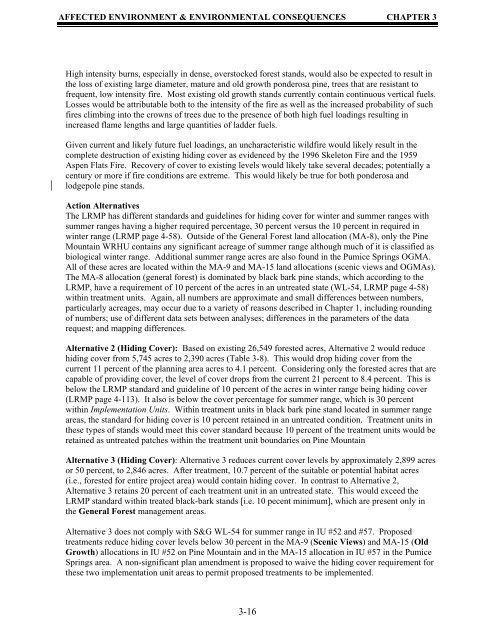Environmental Assessment
Environmental Assessment
Environmental Assessment
Create successful ePaper yourself
Turn your PDF publications into a flip-book with our unique Google optimized e-Paper software.
AFFECTED ENVIRONMENT & ENVIRONMENTAL CONSEQUENCES CHAPTER 3<br />
High intensity burns, especially in dense, overstocked forest stands, would also be expected to result in<br />
the loss of existing large diameter, mature and old growth ponderosa pine, trees that are resistant to<br />
frequent, low intensity fire. Most existing old growth stands currently contain continuous vertical fuels.<br />
Losses would be attributable both to the intensity of the fire as well as the increased probability of such<br />
fires climbing into the crowns of trees due to the presence of both high fuel loadings resulting in<br />
increased flame lengths and large quantities of ladder fuels.<br />
Given current and likely future fuel loadings, an uncharacteristic wildfire would likely result in the<br />
complete destruction of existing hiding cover as evidenced by the 1996 Skeleton Fire and the 1959<br />
Aspen Flats Fire. Recovery of cover to existing levels would likely take several decades; potentially a<br />
century or more if fire conditions are extreme. This would likely be true for both ponderosa and<br />
lodgepole pine stands.<br />
Action Alternatives<br />
The LRMP has different standards and guidelines for hiding cover for winter and summer ranges with<br />
summer ranges having a higher required percentage, 30 percent versus the 10 percent in required in<br />
winter range (LRMP page 4-58). Outside of the General Forest land allocation (MA-8), only the Pine<br />
Mountain WRHU contains any significant acreage of summer range although much of it is classified as<br />
biological winter range. Additional summer range acres are also found in the Pumice Springs OGMA.<br />
All of these acres are located within the MA-9 and MA-15 land allocations (scenic views and OGMAs).<br />
The MA-8 allocation (general forest) is dominated by black bark pine stands, which according to the<br />
LRMP, have a requirement of 10 percent of the acres in an untreated state (WL-54, LRMP page 4-58)<br />
within treatment units. Again, all numbers are approximate and small differences between numbers,<br />
particularly acreages, may occur due to a variety of reasons described in Chapter 1, including rounding<br />
of numbers; use of different data sets between analyses; differences in the parameters of the data<br />
request; and mapping differences.<br />
Alternative 2 (Hiding Cover): Based on existing 26,549 forested acres, Alternative 2 would reduce<br />
hiding cover from 5,745 acres to 2,390 acres (Table 3-8). This would drop hiding cover from the<br />
current 11 percent of the planning area acres to 4.1 percent. Considering only the forested acres that are<br />
capable of providing cover, the level of cover drops from the current 21 percent to 8.4 percent. This is<br />
below the LRMP standard and guideline of 10 percent of the acres in winter range being hiding cover<br />
(LRMP page 4-113). It also is below the cover percentage for summer range, which is 30 percent<br />
within Implementation Units. Within treatment units in black bark pine stand located in summer range<br />
areas, the standard for hiding cover is 10 percent retained in an untreated condition. Treatment units in<br />
these types of stands would meet this cover standard because 10 percent of the treatment units would be<br />
retained as untreated patches within the treatment unit boundaries on Pine Mountain<br />
Alternative 3 (Hiding Cover): Alternative 3 reduces current cover levels by approximately 2,899 acres<br />
or 50 percent, to 2,846 acres. After treatment, 10.7 percent of the suitable or potential habitat acres<br />
(i.e., forested for entire project area) would contain hiding cover. In contrast to Alternative 2,<br />
Alternative 3 retains 20 percent of each treatment unit in an untreated state. This would exceed the<br />
LRMP standard within treated black-bark stands [i.e. 10 pecent minimum], which are present only in<br />
the General Forest management areas.<br />
Alternative 3 does not comply with S&G WL-54 for summer range in IU #52 and #57. Proposed<br />
treatments reduce hiding cover levels below 30 percent in the MA-9 (Scenic Views) and MA-15 (Old<br />
Growth) allocations in IU #52 on Pine Mountain and in the MA-15 allocation in IU #57 in the Pumice<br />
Springs area. A non-significant plan amendment is proposed to waive the hiding cover requirement for<br />
these two implementation unit areas to permit proposed treatments to be implemented.<br />
3-16
















